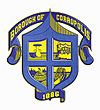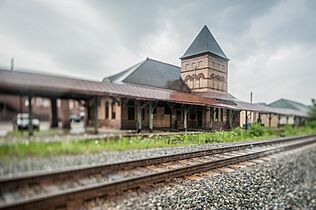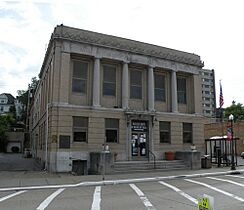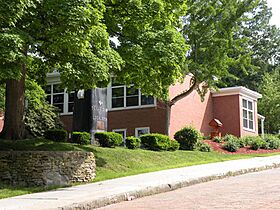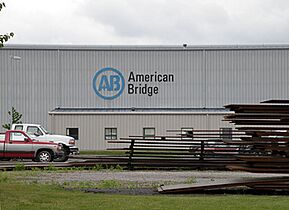Coraopolis, Pennsylvania facts for kids
Quick facts for kids
Coraopolis, Pennsylvania
|
||
|---|---|---|
|
Borough
|
||
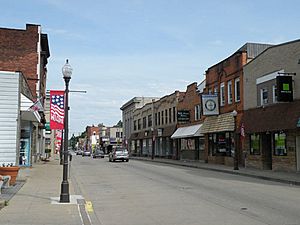
5th Avenue, Coraopolis, Pennsylvania
|
||
|
||
| Etymology: Koreopolis, Greek for "Maiden city" | ||
| Nickname(s):
Cory
|
||

Location in Allegheny County and the U.S. state of Pennsylvania.
|
||
| Country | United States | |
| State | Pennsylvania | |
| County | Allegheny | |
| Settled in 1773 | Incorporated in 1886 | |
| Area | ||
| • Total | 1.46 sq mi (3.79 km2) | |
| • Land | 1.33 sq mi (3.44 km2) | |
| • Water | 0.13 sq mi (0.35 km2) | |
| Population
(2020)
|
||
| • Total | 5,559 | |
| • Density | 4,179.70/sq mi (1,613.71/km2) | |
| Time zone | UTC-5 (EST) | |
| • Summer (DST) | UTC-4 (EDT) | |
| ZIP code |
15108
|
|
| Area code(s) | 412 | |
| FIPS code | 42-16144 | |
| School District | Cornell | |
| Website | Coraopolis | |
Coraopolis (/ˌkoʊriˈɒpəlɪs/) is a small town, called a borough, located in Allegheny County, Pennsylvania, in the United States. It sits right along the Ohio River. In 2020, about 5,559 people lived there. Coraopolis is west of Pittsburgh and east of the Pittsburgh International Airport. It's known for its hilly streets and many older, large houses. Big companies like Dick's Sporting Goods and the American Bridge Company have their main offices here.
Contents
History of Coraopolis
How Coraopolis Began
Long ago, in 1769, a Native American interpreter named Andrew Montour was given a large piece of land where Coraopolis is now. The first permanent white settler was Captain Robert Vance, who arrived around 1773. He was a soldier who fought with George Washington. To protect himself and his neighbors from Native American raids, Vance built a log fort with a stone blockhouse. This fort was called Vance Fort.
Over time, more people moved to the area. The community became known as Middletown in the 1800s. This name might have come from it being midway between Pittsburgh and Beaver, Pennsylvania. Or it could be from an early settler named Alexander Middleton.
One of the first important businesses was a sawmill, built by the Watson family in 1830. Later, they ran a much bigger mill for grinding grain by the river.
Naming the Borough
Coraopolis officially became a borough on June 7, 1886. Before that, it was a village called Middletown. The post office was even called Vancefort for a while.
There's a story that the town was named after Cora Watson, who was born in 1870. However, an old newspaper found by a local historian, Dr. Frank Braden, Jr., tells a different story. It says the name likely came from a Greek word.
In 1897, the News newspaper explained the confusion. Many places in Pennsylvania were called Middletown, which caused problems for the post office. When the borough was formed, Reverend Josiah Dillon, a pioneer clergyman and the first mayor (called a burgess), suggested a new name. He knew Greek and combined Kore (meaning 'maiden') and opolis (meaning 'city'). This made Koreopolis, or "maiden city." When the Greek name was written in English, the spelling accidentally changed to Coraopolis.
The borough was built on land owned by James Harvey McCabe. He was chosen as the first mayor. He helped the new government get started smoothly. He also played a big part in bringing the Pittsburg and Lake Erie Railroad through the borough.
Growing into a Modern Town
Coraopolis grew a lot when the Pittsburgh and Lake Erie Railroad was built in 1877. Many local residents invested in this railroad. Later, the P&LE started the Montour Railroad to bring coal from nearby mines. The Montour Railroad's main office was in Coraopolis. It ran for 50 miles, connecting to many coal mines. The railroad closed in the 1980s when the coal ran out. Its old path is now part of the Montour Trail, a popular walking and biking trail.
In 1892, Coraopolis saw even more growth with the first high-speed electric street railway in the United States. This railway connected downtown Pittsburgh to Sewickley, passing through Coraopolis. Streetcars ran until 1955.
The railway also brought the Consolidated Lamp and Glass Company to Coraopolis in 1895. This company employed up to 350 people, making glass products until 1963. Other Coraopolis residents worked for new industries on Neville Island. The Shafer Bus Line, headquartered in Coraopolis, served the western part of Allegheny County until 1960.
Another important company was Standard Steel Spring Company, which later became part of North American Rockwell Steel Corporation. From 1900 to 1960, this plant made springs, bumpers, and frames for vehicles. It was a huge employer, with 10,000 men working in shifts.
Coraopolis built its first town hall in 1897. A new one was built in 1929. In 2017, a brand new municipal complex opened on Fourth Avenue. It now holds all the town's departments, including the police and fire stations.
Coraopolis has also contributed to education. In 1955, Dr. Harry Houtz showed that teaching reading with phonics (sounding out words) was very effective. In 1957, Herbert Snell studied how to group students by their academic performance, which became a widely used method. In 1971, Coraopolis and Neville Township combined their schools to form the Cornell School District. All students moved to the new Cornell Educational Center in 1976.
Today, Coraopolis is seeing new life! Many new shops, restaurants, and breweries have opened in the downtown area. The town is also building a new sports complex with neighboring towns for soccer, rugby, and lacrosse. The old train station from 1896, which has a unique Richardsonian Romanesque style, is being restored. It will become a community center and event space.
Geography of Coraopolis
Coraopolis is located at 40°30′57″N 80°9′46″W / 40.51583°N 80.16278°W. It covers about 1.5 square miles (3.79 square kilometers). Most of this area is land, but about 0.1 square miles (0.35 square kilometers) is water, mainly from the Ohio River.
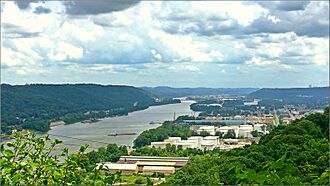
Coraopolis sits on the southern bank of the Ohio River. It shares land borders with Moon Township to the south and west, and Robinson Township to the southeast. Across a smaller channel of the Ohio River, Coraopolis is connected to Neville Island (Neville Township) by the Coraopolis Bridge. It is also close to the towns of Haysville, Glen Osborne, and Sewickley across the main Ohio River.
Population and People
| Historical population | |||
|---|---|---|---|
| Census | Pop. | %± | |
| 1890 | 962 | — | |
| 1900 | 2,555 | 165.6% | |
| 1910 | 5,252 | 105.6% | |
| 1920 | 6,162 | 17.3% | |
| 1930 | 10,724 | 74.0% | |
| 1940 | 11,086 | 3.4% | |
| 1950 | 10,498 | −5.3% | |
| 1960 | 9,643 | −8.1% | |
| 1970 | 8,435 | −12.5% | |
| 1980 | 7,308 | −13.4% | |
| 1990 | 6,747 | −7.7% | |
| 2000 | 6,131 | −9.1% | |
| 2010 | 5,677 | −7.4% | |
| 2020 | 5,559 | −2.1% | |
| Sources: | |||
In 2000, Coraopolis had 6,131 people living in 2,880 households. About 21.4% of households had children under 18. The average household had about 2.10 people. The average family had about 2.85 people.
The population was spread out by age:
- 19.4% were under 18
- 7.2% were 18 to 24
- 30.3% were 25 to 44
- 21.6% were 45 to 64
- 21.5% were 65 or older
The average age in Coraopolis was 41 years old.
Famous People from Coraopolis
Coraopolis is the hometown of some well-known individuals:
- Bill DeVenzio, a professional basketball player.
- Dane Jackson, a professional football player.
- Michael Keaton, a famous actor and director.
- John Hufnagel, a Canadian Football League quarterback, coach, and general manager, especially with the Calgary Stampeders.
- Jerry Gibson, a Negro league baseball player, who played for the Coraopolis Grays.
Gallery
See also
 In Spanish: Coraopolis para niños
In Spanish: Coraopolis para niños


